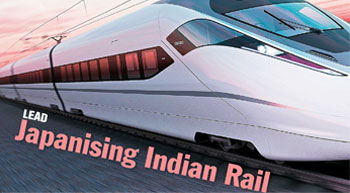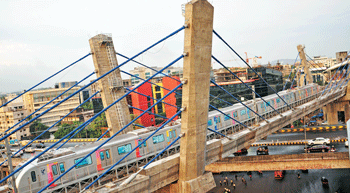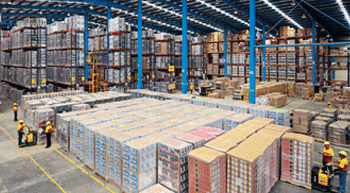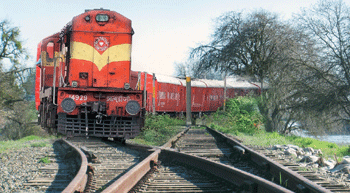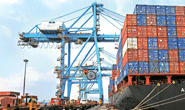Taking precedence from Japan which heralded the ´bullet train´ legacy in 1964, the world began to partake of this ´race against time´. High-speed rail (HSR), which uses an integrated system of specialised rolling stock and dedicated tracks, can significantly enhance the connectivity and trade between major cities in a country.
FlashNews:
India Begins Hydrogen Car Trials as Minister Joshi Drives Toyota Mirai to Parliament
MNRE Refutes Financing Pause; Calls for Expansion into Upstream Solar Manufacturing
IndiGrid to Acquire Gadag Transmission for ₹3.72 Billion
India Launches First All‑Electric Tug at Deendayal Port, Accelerates Green Maritime Shift
Bharatmala Pariyojana Executes 61% of Phase‑I Highway Targets, Boosts Freight Speed and Connectivity
Waaree Tops India’s Solar Module Shipments in Q3 2025, Reinforces Global Competitiveness
AISATS Expands Nationwide, Launches Ground Handling at Cochin Airport with Future‑Ready Tech
TIL Bags ₹2 Billion Orders Across Defence and Logistics, Validates Dual-Sector Strategy
Indian Railways to Roll Out OTP‑Based Tatkal Window Tickets Nationwide to Curb Misuse
Sanchar Saathi Row: Scindia Defends App as Voluntary, Transparent and Consumer‑Protective Amid Privacy Debate
REIAs Issue 67.5 GW Renewable Energy LoAs Since April 2023 with Zero Cancellations: Joshi
Rail Freight Rises 4.2% in November as Steel, Iron Ore and Fertiliser Volumes Surge
NHAI Partners Reliance Jio to Launch Telecom‑Based Safety Alerts on National Highways
Delhi Airport Becomes India’s First Water‑Positive Major Aviation Hub
Civil Aviation Minister Confirms GPS Spoofing at Delhi Airport; Cyber Threats Spread to Major Hubs
India’s Power Capacity Crosses 505,000 MW, Clean Energy Transition Accelerates
Air India Express Launches Twice-Daily Nagpur-Bengaluru Flights, Expands Maharashtra Network
India to Expand Refining Capacity to 309.5 MMTPA by 2030, Accelerates Biofuel and Green Hydrogen Push
Air India Expands China Presence with TAM Group Appointment as Passenger GSA
Rationale behind HSR
An investment in HSR is typically a government decision which is primarily dependent on a number of factors, such as current and projected traffic, expected saving in time, and a reduction in accidents due to a modal shift, reduction in environmental externalities, ease in congestion in existing modes, and the average willingness of the users to pay.
TRAILBLAZERS
A buzzing campus, enthusiastic students, a well-organised event, distinguished and exemplary speakers all made for a day´s worth of good entertainment but also important information and keen insights on infrastructure in India
Funding Dichotomy
The population surge, rapid urbanisation, and the consequent congestion have time and again fuelled the ´need for speed´. Mass rapid transit system like the metro rail has dawned as a panacea in this regard.
SEZs: Relevance & future
Unlike China, the original concept of SEZs in India got diluted and it witnessed growth of numerous small scale SEZs, pre-dominantly in the IT/ ITeS space. Further, absence of a true ´single window´ to operationalise SEZ
Ultra-modern ´godowns´
Warehousing market is pegged at Rs 56,000 crore and is expected to grow annually at an average rate of 8 to 10 per cent over the next 5 years to reach a level of 1500 to 1600 million sq ft by 2020.
Can Prabhu bring Indian Railways on track?
Despite having the second largest rail network in the world, Indian Railways (IR) has not been able to bring it on growth trajectory. The rail sector is infested with challenges like snail´s pace expansion and modernisation, poor customer service
Open Sesame!
Public Sector Units (PSUs) will be pushing the growth engine of the country, be it through almost 18 lakh acres of land reserves with these companies or the cash reserves of almost Rs 2,00,230 crore kept as bank deposits by these enterprises.
Delhi Metro makes it to global list
Delhi Metro is one of the six Indian projects to feature in the prestigious Infrastructure 100: World Markets Report compiled KPMG.
Neighbours´ envy, India´s pride?
Vallarpadam in Cochin run by Dubai´s DP World Ltd is slated to have a companion in Vizhinjam near Thiruvananthapuram as the new transshipment facility.


